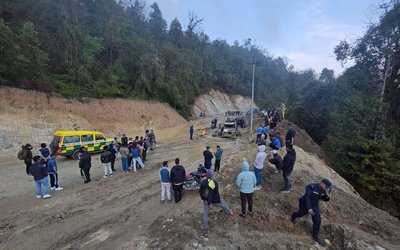Acute mountain sickness ( AMS) is a warning, a red flag. At about 2500 m or higher as you trek (and the trekking season is upon us) you may suffer from “hangover symptoms”, headache and nausea. If you descend a few hundred meters you can feel these symptoms lift and you will experience cure. Usually with just AMS, if you don’t go any higher and take it easy at the same altitude, there is every likelihood that you will get better.
It is when people with AMS push themselves and try to ascend higher due to money and time invested to reach your destination ( Kalapttar, Thorang La) peer pressure, or overriding ego that dangerous complications may ensue. The life threatening complications are water in the brain( high altitude cerebral edema, HACE) or water in the lungs ( high altitude pulmonary edema, HAPE). The water seeps out of the blood vessels in these important organs primarily due to lack of oxygen brought on by the inability to acclimatize properly. Proper acclimatization prevents flooding of these vital organs. HAPE and HACE mandate immediate descent ( by foot, yak, horse, a porter’s back, or a helicopter).
The Himalaya Rescue Association rule book half jokingly says that it is OK to suffer from AMS but it is not OK to die from it. So preventive aspects of this Lekh Lagne ( altitude sickness in Nepali) are important, the most important being “listen to your body”. Many people who suffer from HAPE and HACE disregard the initial hangover symptoms and keep ascending. The sea level rule about ” when the going gets tough, the tough get going” is counterproductive at high altitude. Indeed the strong and silent John Wayne attitude would be risky behaviour at high altitude. So don’t rush up the mountain. Drink adequate fluids ( about 3 liters per day); do not sleep higher than 300 to 500 m from the previous night’s altitude as far as possible; have rest day every third day on your trek and check out the “climb high sleep low” technique; and use diamox ( acetazolamide), if you don’t have sulpha allergy, 250 mg two time a day if necessary.
Finally vulnerable populations like porters, pilgrims, and clueless government workers on assignment to remote high altitude villages also succumb to altitude sickness. It’s not just the trekkers and climbers!

Buddha Basnyat MD
Buddha Basnyat, MD, MSc, FACP, FRCP, Director of the Oxford University Clinical Research Unit-Patan Academy of Health Sciences, Kathmandu.
- Altitude Sickness
- Feb 20, 2018
- Post-earthquake Nepal: The Way Forward
- Dec 13, 2015
- The Annapurna Sanctuary
- Nov 29, 2015
- Diarrhea at the Summit
- Nov 08, 2015
- Tackle Nepal’s Typhoid Problem Now
- Sep 25, 2015















